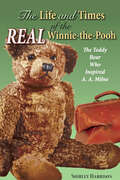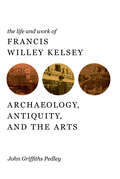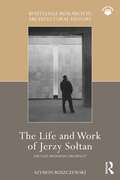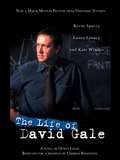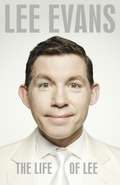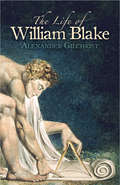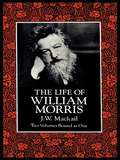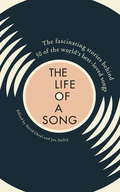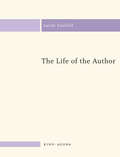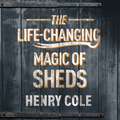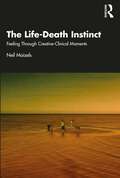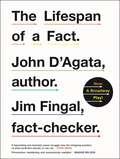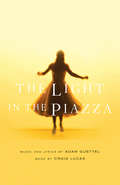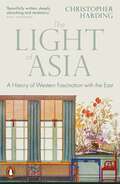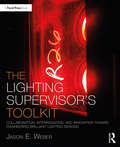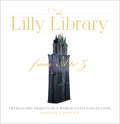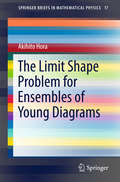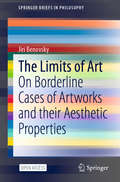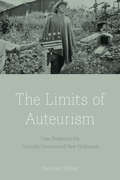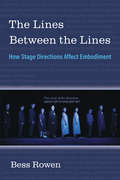- Table View
- List View
The Life and Times of the Real Winnie-the-Pooh: The Teddy Bear Who Inspired A. A. Milne
by Shirley Harrison"Once upon a time an anonymous teddy bear set off, from a factory in a north London suburb with a van-load of similar bears and other toys. His spectacular journey was to take him into the hearts of people of all ages, around the world and that is where we will join him first-in Acton where it all began." -Shirley Harrison, from the introductionThe story truly does begin in Acton, England, at the Farnell toy factory where the hand-made mohair bear was born. This biography traces the steps of the actual stuffed bear from his creation to his final resting place in the Children's Center of the New York Public Library. Winnie-the-Pooh was brought to life as a loveable playmate flowing from the vivid imagination of Christopher Robin and introduced to the world by his father, A. A. Milne. Shirley Harrison uses original documents, photographs, and the diaries of the late Elliot Graham, caretaker to the bear for more than forty years, to give a glimpse into the hidden world of Winnie-the-Pooh and those whose lives he changed forever. Well-researched details flesh out the myths surrounding Winnie-the-Pooh's name, his journey to American, and his brief return to England. Filled with details of the real Christopher Robin, his mother, father, and the impact the stories had on their lives and illustrated with photographs of the people and places that brought the bear to life, this book chronicles the origins of one of the best-loved children's series in the world and focuses on the stuffed toy that started it all.
The Life and Work of Francis Willey Kelsey: Archaeology, Antiquity, and the Arts
by John Griffiths PedleyPresident of the Archaeological Institute of America, professor at the University of Michigan from 1889 to 1927, and president of the American Philological Association, Francis Kelsey was crucially involved in the founding or growth of major educational institutions. He came to maturity in a period of great technological change in communications, transportation, and manufacturing. Kelsey took full advantage of such innovations in his ceaseless drive to promote education for all, to further the expansion of knowledge, and to champion the benefits of the study of antiquity. A vigorous traveler around the United States, Europe, and the Mediterranean, Kelsey strongly believed in the value of personally viewing sites ancient and modern and collecting artifacts that could be used by the new museums and universities that were springing up in the United States. This collecting habit put him in touch with major financiers of the day, including Charles Freer, Andrew Carnegie, and J. P. Morgan, as he sought their help for important projects. Drawing heavily on Kelsey's daily diaries now held at the University of Michigan's Bentley Historical Library, John Griffiths Pedley gives us a biography that records the wide-ranging activities of a gifted and energetic scholar whose achievements mirrored the creative and contributive innovations of his contemporary Americans.
The Life and Work of Jerzy Sołtan: the “last modernist architect” (Routledge Research in Architectural History)
by Szymon RuszczewskiThis book is the first comprehensive monograph on Polish modern architect Jerzy Sołtan’s work including his designs, theory, and teachings in Poland and America based on extensive archival research and oral history interviews with former students. The Life and Work of Jerzy Sołtan takes the reader on a journey to both sides of the iron curtain, the communist Poland and the capitalist United States, contributing to the existing scholarship on modernism in post-socialist counties, on CIAM, and on Team 10. It pictures Sołtan as a central player in the history of modernism, building on his own contribution and on close relationships with Le Corbusier and Team 10. This book illustrates not only Sołtan’s work but also his life and how it influenced twentieth-century architecture. Looking in detail at his designs and texts enables the reader to discover how modern architecture tendencies can fit into a larger geopolitical context and how designs can be true manifestos to an architect’s theory. The reader will be immersed in a series of different contexts – from communist Poland, the vibrant academic atmosphere at Harvard to lively discussions on the future of modern architecture. This publication will be of particular interest for those studying modern architecture in Central Europe and in post-socialist countries, in particular Poland. Architects, designers, architectural and design students, and modern architecture enthusiasts will find this publication on the “last modernist” architect revealing new perspectives thanks to the unpublished and unresearched sources.
The Life of David Gale
by Dewey GramDavid Gale, a Texas professor and advocate for the elimination of the death penalty, is falsely accused of the rape and murder of a fellow activist. He relates his story via flashbacks to a reporter visiting him on death row. Based on the original screenplay.
The Life of Lee
by Lee EvansLee Evans is one of the best-loved comedians in the country; a Hollywood star able to sell out arenas in the blink of eye. But he was not always such a roaring success. The Life of Lee is an utterly hilarious and very moving autobiography charting his ups and downs on the way to the top. Lee takes us on a darkly humorous journey through his childhood spent running wild on a Bristol housing estate and his unconventional school days, when he was publicly derided as 'a failure' by a sadistic teacher. In this brilliantly entertaining and engaging tale, he also guides us through a grim teenage period of numerous dead-end jobs. When he was cleaning toilets and plucking turkeys, he could never have imagined that one day he would be playing to thousands of adoring fans at the O2 Arena. The book also reveals how as a boy Lee got his first taste of showbiz, living out of a suitcase and accompanying his entertainer father around the smoky, rowdy, unforgiving working-men's club and theatre circuit. Desperately struggling to be accepted, this quiet young loner always saw himself as an outsider. But he finally met the love of his life and accidentally discovered the one place where he felt at home: the stage. The Life of Lee is a story that is like its subject: compelling, touching, charming and, above all, fantastically funny.
The Life of Rylan
by Rylan Clark-Neal*The Sunday Times Number One Bestseller*Well hark at you, stumbling upon my autobiography. Bet you wouldn't have put money on that three years ago, eh?! Please don't stress yourself out too much, though, it's actually socially acceptable nowadays that you're interested. Firstly I'd like to emphasise that I have WRITTEN THIS BOOK MYSELF, so be assured you're getting the TOOTH, the WHOLE TOOTH and NOTHING BUT THE TOOTH! (Which was my original choice of title, but babe, we're so over that.) This book documents my story, year by year, from my humble beginnings growing up in the East End of London, becoming one of the nation's most talked-about people overnight to finally moving up the spectrum from guilty pleasure, and getting nearer to national treasure.It will make you laugh, cry, and most importantly you'll discover who I really am. If it doesn't do any of those things you're not legally entitled to a refund - just clearing that up ;-).I hope you enjoy reading this book as much as I have enjoyed writing it. This book has been like therapy, and LORD was I in need. Enjoy!
The Life of William Blake
by Alexander GilchristOne of the greatest Victorian-era biographies, Alexander Gilchrist's The Life of William Blake plays a key role in the history of Blake's work and its influence on other writers and artists. The first standard text on Blake and a cornerstone of the extensive scholarship on his life and work, it not only delivered its subject from unjust obscurity but also dispelled the notion of Blake's insanity and established his genius as a visionary artist and poet.Sensitive, highly readable accounts trace Blake's childhood and years as an engraver's apprentice, his relations with patrons and employers, his trial for treason, and his declining health and untimely death. The author's wide-ranging research includes interviews with many of Blake's surviving friends, whose personal recollections add warmth and immediacy to this portrait. Extensive quotes from the subject's poetry and prose — practically unknown at the time of the original 1863 publication — further enliven the text. In addition to a critical commentary on Blake's boyhood poems, this transformative biography features more than 40 of his illustrations.
The Life of William Morris
by J. W. MackailClassic biography of the great Victorian poet, designer and socialist. Published a few years after Morris’ death, it chronicles his childhood, days at Oxford, forays into art and literature, embrace of socialism, involvement with the Arts and Crafts movement, founding of the Kelmscott Press, much more. 22 black-and-white illustrations.
The Life of a Geisha
by Liza Dalby Eleanor UnderwoodTHE LIFE OF A GEISHA illustrates the fascinating world of Japan's powerful and seductive geishas, a fading yet beautiful world that has captured the imaginations of millions of readers. This striking book contains full-color woodblock prints made during Japan's famous Edo Period, historic and contemporary photographs of geisha life, and images of the "floating world," Japan's mysterious artistic subculture. The accompanying text includes evocative Japanese poems and haikus. All celebrate the beauty and creativity of the geisha, who with her exquisitely detailed costume, elaborate makeup and hairstyle, and artfully ritualized behavior, chastely beguiles and entertains Japan's most powerful men.
The Life of a Geisha
by Liza Dalby Eleanor UnderwoodTHE LIFE OF A GEISHA illustrates the fascinating world of Japan's powerful and seductive geishas, a fading yet beautiful world that has captured the imaginations of millions of readers. This striking book contains full-color woodblock prints made during Japan's famous Edo Period, historic and contemporary photographs of geisha life, and images of the "floating world," Japan's mysterious artistic subculture. The accompanying text includes evocative Japanese poems and haikus. All celebrate the beauty and creativity of the geisha, who with her exquisitely detailed costume, elaborate makeup and hairstyle, and artfully ritualized behavior, chastely beguiles and entertains Japan's most powerful men.
The Life of a Song: The fascinating stories behind 50 of the world's best-loved songs
by David Cheal Jan DalleyWho knew that Paul McCartney originally referred to Yesterday as 'Scrambled Eggs' because he couldn't think of any lyrics for his heart-breaking tune? Or that Patti LaBelle didn't know what 'Voulez-vous couches avec moi ce soir?' actually meant? These and countless other fascinating back stories of some of our best-known and best-loved songs fill this book, a collection of the highly successful weekly The Life of a Song columns that appear in the FT Weekend every Saturday. Each 600-word piece gives a mini-biography of a single song, from its earliest form (often a spiritual, or a jazz number), through the various covers and changes, often morphing from one genre to another, always focusing on the 'biography' of the song itself while including the many famous artists who have performed or recorded it.The selection covers a wide spectrum of the songs we all know and love - rock, pop, folk, jazz and more. Each piece is pithy, knowledgeable, entertaining, full of anecdotes and surprises. They combine deep musical knowledge with the vivid background of the performers and musicians, and of course the often intriguing social and political background against which the songs were created.
The Life of the Author
by Sarah KozloffWhen Roland Barthes and Michel Foucault proclaimed the "death of the author" fifty years ago, they did so in the name of freedom. They could never have foreseen that its indiscriminate embrace by many film theorists would turn the anti-authorship stance into a restrictive orthodoxy. Sarah Kozloff daringly advocates a new paradigm, a theory of film authorship that takes into account flesh-and-blood filmmakers, including their biographies, their intentions and their collaborations. Building upon scholarship by Noël Carroll, Paisley Livingstone, Robert Carringer and Paul Sellors, Kozloff argues that we watch films in large part to feel a sense of communion with the people behind them. Writing with clarity and verve, Kozloff moves gracefully back and forth between film history and film theory. She offers an extended examination of The Red Kimona (1925) in order to demonstrate how knowledge about the people who created this intriguing early feminist movie can change a viewer's interpretation. "I believe art works are made by people operating (struggling) within their historical moment. Without denying or downplaying larger cultural forces – indeed, while drawing them into the mix – I want to study films from this standpoint. Yet, I do not think of myself as a naïve fan. Filmmakers as famous, successful celebrities hold no interest for me. If I am teaching or studying a film, however, I do want to know how the filmmakers' biographies, intentions and agency combine with these larger social structures to influence the text before me." — Sarah Kozloff
The Life-Changing Magic of Sheds
by Henry ColeThe ultimate guide to sheds from the renowned presenter of Shed and Buried.When it comes to truly finding out who you are and what makes you tick, there is one thing that needs no online subscription to a cloud-based server with a password you keep forgetting. That, my friend, is a shed.Your shed is your refuge. It's the place where you go when you need a break from this mad, crazy world. But a shed can only help you if it's not attached to the house. The minute you attach the shed to the gaff, or confuse the concept of a shed with the concept of a conservatory, or a home office or a Shepherd's Hut, you're doing yourself over. You're never, ever going to get spiritual enlightenment in a lean-to. That's like going to find yourself in Thailand, and staying in the airport.You need to make that pilgrimage to the bottom of the garden. Whether you're walking down a muddy track or crunching along a perfect gravel path, you have to get out of the house. Breathe in the fresh air. Then pull open the door, grapple for the light switch, fire up the heaters and turn on the kettle. Once you're inside the four walls of your shed, you can do whatever you like. You're the king in there.
The Life-Changing Magic of Sheds
by Henry ColeThe ultimate guide to sheds from the renowned presenter of Shed and Buried.When it comes to truly finding out who you are and what makes you tick, there is one thing that needs no online subscription to a cloud-based server with a password you keep forgetting. That, my friend, is a shed.Your shed is your refuge. It's the place where you go when you need a break from this mad, crazy world. But a shed can only help you if it's not attached to the house. The minute you attach the shed to the gaff, or confuse the concept of a shed with the concept of a conservatory, or a home office or a Shepherd's Hut, you're doing yourself over. You're never, ever going to get spiritual enlightenment in a lean-to. That's like going to find yourself in Thailand, and staying in the airport.You need to make that pilgrimage to the bottom of the garden. Whether you're walking down a muddy track or crunching along a perfect gravel path, you have to get out of the house. Breathe in the fresh air. Then pull open the door, grapple for the light switch, fire up the heaters and turn on the kettle. Once you're inside the four walls of your shed, you can do whatever you like. You're the king in there.(P)2020 Quercus Editions Limited
The Life-Death Instinct: Feeling Through Creative-Clinical Moments
by Neil MaizelsThroughout this enlightening collection, Neil Maizels considers the helical tandem between the Life Instinct and the Death drive in the light of canonical literary figures like Thomas Hardy, Patricia Highsmith, Sylvia Plath and Shakespeare, classic filmmakers like Hitchcock and contemporary television shows such as Curb Your Enthusiasm, The West Wing and Succession. This light is filtered through intricate clinical work whereby Maizels seeks to illustrate and expound on the strength and indefatigability of the Life Instinct. He makes a case for it as the relentless driver of integration and “binding” in the ever-growing, expansive psyche. He considers both Freud’s original equation of the Life Instinct with Eros and a widening interconnecting love of mankind, and Melanie Klein’s with gratitude and creative reparation. This book is a multi-layered presentation of the clinical and theoretical work of Neil Maizels as it has evolved and convolved over several decades. It places the feeling through of one’s conflicts at the heart of the mind’s generation of a unique identity, equipped to evolve its own unique form of creative spirit in the face of life’s most pressing psychological challenges: the limitation of time, and reciprocated beauty. The Life-Death Instinct: Feeling Through Creative-Clinical Moments is important reading for anyone seeking to expand their knowledge in this fascinating intersection of psychoanalysis and the arts.
The Lifespan of a Fact: Now a Broadway Play
by John D'Agata Jim FingalNOW A BROADWAY PLAY STARRING DANIEL RADCLIFFE'Provocative, maddening and compulsively readable' Maggie NelsonIn 2003, American essayist John D'Agata wrote a piece for Harper's about Las Vegas's alarmingly high suicide rate, after a sixteen-year-old boy had thrown himself from the top of the Stratosphere Tower.The article he delivered, 'What Happens There', was rejected by the magazine for inaccuracies. But it was soon picked up by another, who assigned it a fact checker: their fresh-faced intern, and recent Harvard graduate, Jim Fingal. What resulted from that assignment, and beyond the essay's eventual publication in the magazine, was seven years of arguments, negotiations, and revisions as D'Agata and Fingal struggled to navigate the boundaries of literary nonfiction.This book includes an early draft of D'Agata's essay, along with D'Agata and Fingal's extensive discussion around the text. The Lifespan of a Fact is a brilliant and eye-opening meditation on the relationship between 'truth' and 'accuracy', and a penetrating conversation about whether it is appropriate for a writer to substitute one for the other.'A fascinating and dramatic power struggle over the intriguing question of what nonfiction should, or can, be' Lydia Davis
The Light Years: A Memoir
by Chris RushThe Light Years is a joyous and defiant coming-of-age memoir set during one of the most turbulent times in American history"This stunningly beautiful, original memoir is driven by a search for the divine, a quest that leads Rush into some dangerous places . . . The Light Years is funny, harrowing, and deeply tender." —Kate Tuttle, The L.A. Times"Rush is a fantastically vivid writer, whether he’s remembering a New Jersey of 'meatballs and Windex and hairspray' or the dappled, dangerous beauty of Northern California, where 'rock stars lurked like lemurs in the trees.' Read if you loved… Just Kids by Patti Smith." —Leah Greenblatt, Entertainment Weekly“As mythic and wild with love, possibility, and danger as the decades it spans, you’ll read The Light Years with your breath held. Brutal, buoyant and wise to the tender terror of growing up, Chris Rush has written a timeless memoir of boyhood in the American wilderness.” —Emma Cline, author of The GirlsChris Rush was born into a prosperous, fiercely Roman Catholic, New Jersey family. But underneath the gleaming mid-century house, the flawless hostess mom, and the thriving businessman dad ran an unspoken tension that, amid the upheaval of the late 1960s, was destined to fracture their precarious facade. His older sister Donna introduces him to the charismatic Valentine, who places a tab of acid on twelve-year-old Rush’s tongue, proclaiming: “This is sacrament. You are one of us now.”After an unceremonious ejection from an experimental art school, Rush heads to Tucson to make a major drug purchase and, still barely a teenager, disappears into the nascent American counterculture. Stitching together a ragged assemblage of lowlifes, prophets, and fellow wanderers, he seeks kinship in the communes of the west. His adolescence is spent looking for knowledge, for the divine, for home. Given what Rush confronts on his travels—from ordinary heartbreak to unimaginable violence—it is a miracle he is still alive.The Light Years is a prayer for vanished friends, an odyssey signposted with broken and extraordinary people. It transcends one boy’s story to perfectly illustrate the slow slide from the optimism of the 1960s into the darker and more sinister 1970s. This is a riveting, heart-stopping journey of discovery and reconciliation, as Rush faces his lost childhood and, finally, himself.
The Light in the Piazza
by Craig Lucas Adam Guettel"The Light in the Piazza beautifully captures the eternal allure of Italy. . . . The story wraps itself around your heart."--Chicago Sun-Times"Guettel's music and lyrics take nothing from the razzle-dazzle bargain basement of feeling; they represent, instead, a genuine expense of spirit. . . . The Light in the Piazza doesn't want to make theatre-goers feel good; it wants to make them feel deeply."--The New Yorker"With Adam Guettel's gorgeous melodies, a compelling narrative hook from Craig Lucas, and moving themes about happiness and risk, there's no question that The Light in the Piazza is Broadway worthy."--Daily VarietyComposer Adam Guettel, best known for his Floyd Collins, has teamed with Prelude to a Kiss playwright Craig Lucas to create a passionate and soaring new musical based on Elizabeth Spencer's 1960 novella, which was first published as an entire issue of The New Yorker. It is the story of an American ingénue abroad, whose chance meeting of a charming young Italian in a Florentine piazza sets off a whirlwind romance--with an unsettling revelation. The Light in the Piazza opens on Broadway at the Lincoln Center Theater this spring after major productions already in Seattle and Chicago.Adam Guettel wrote music and lyrics for Floyd Collins, produced across the country and in London. His other works include Love's Fire, a collaboration with John Guare, and Saturn Returns, a concert at The Public Theater/New York Shakespeare Festival that was recorded by Nonesuch Records under the title Myths and Hymns.Craig Lucas won this year's Obie Award for Best American Play for Small Tragedy and the New York Film Critics Award for Best Screenplay for The Secret Lives of Dentists. His other plays include Reckless, Blue Window, Prelude to a Kiss, God's Heart, The Dying Gaul, Missing Persons, Stranger, and Singing Forest.
The Light of Asia: A History of Western Fascination with the East
by Christopher HardingThis rich and enjoyable book by the acclaimed author of Japan Story explores the many ways in which Asia has influenced Europe and North America over centuries of tangled, dynamic encountersFrom the time of the ancient Greeks onwards the West's relationship with Asia consisted for the most part of outrageous tales of strange beasts and monsters, of silk and spices shipped over vast distances and an uneasy sense of unknowable empires fantastically far away. By the twentieth century much of Asia might have come under Western rule after centuries of warfare, but its intellectual, artistic and spiritual influence was fighting back.The Light of Asia is a wonderfully varied and entertaining history of the many ways in which Asia has shaped European and North American culture over centuries of tangled, dynamic encounters, and the central importance of this vexed, often confused relationship. From Marco Polo onwards Asia has been both a source of genuine fascination and equally genuine failures of comprehension. China, India and Japan were all acknowledged to be both great civilizations and in crude ways seen as superseded by the West. From Chicago to Calcutta, and from antiquity to the new millennium, this is a rich, involving story of misunderstandings and sincere connection, of inspiration and falsehood, of geniuses, adventurers and con-men.Christopher Harding's captivating gallery of people and places celebrates Asia's impact on the West in all its variety.
The Lighting Supervisor's Toolkit: Collaboration, Interrogation, and Innovation toward Engineering Brilliant Lighting Designs (The Focal Press Toolkit Series)
by Jason E. WeberThe Lighting Supervisor’s Toolkit guides readers through the Lighting Supervisor’s production process with an emphasis on the importance of the collaborative nature of the role. Lifting the veil on a process regularly learned on the job, this book offers a deeper understanding of the role of Lighting Supervisor and how to take lighting designs from dreams to reality. Readers will learn to communicate with designers, analyze drawings, plan installations, document decisions, supervise crews, and innovate out-of-the-box solutions. Providing guidance for technically focused individuals seeking deeper understanding of the profession, The Lighting Supervisor’s Toolkit is ideal for students and professional technicians looking to take on important leadership roles in theatrical and entertainment lighting.
The Lilly Library from A to Z: Intriguing Objects in a World-Class Collection (Well House Books)
by Darlene J. SadlierA beautifully illustrated look inside of Indiana University Bloomington’s renowned library of rare books, manuscripts, and related oddities. What do locks of Edgar Allan Poe’s hair, Sylvia Plath’s attractive handmade paper dolls, John Ford’s Oscars, and Ian Fleming’s James Bond 007 cigars have in common? They are just a few of the fascinating objects found in the world-famous Lilly Library, located on the campus of Indiana University Bloomington. In this beautifully illustrated A-to-Z volume, Darlene J. Sadlier journeys through the library’s wide-ranging collections to highlight dozens of intriguing items and the archives of which they are a part. Read about life and death masks of John Keats, Abraham Lincoln, and Theodore Dreiser; Walt Whitman’s last pencil; and vintage board games, mechanical puzzles, and even comic books. Among the more peculiar items are a pair of elk teeth and an eerily realistic wall-mount bust of Boris Karloff. Sadlier writes engagingly about the Lilly Library’s major historical collections, which include Civil War diaries and a panopticon of the war called the Myriopticon; War of 1812 payment receipts to spies; and the World War II letters and V-mail of journalist Ernie Pyle. This copiously illustrated, entertaining, and educational book will inspire you to take your own journey and discover for yourself the wonders of the Lilly Library.
The Limit Shape Problem for Ensembles of Young Diagrams
by Akihito HoraThis book treats ensembles of Young diagrams originating from group-theoretical contexts and investigates what statistical properties are observed there in a large-scale limit. The focus is mainly on analyzing the interesting phenomenon that specific curves appear in the appropriate scaling limit for the profiles of Young diagrams. This problem is regarded as an important origin of recent vital studies on harmonic analysis of huge symmetry structures. As mathematics, an asymptotic theory of representations is developed of the symmetric groups of degree n as n goes to infinity. The framework of rigorous limit theorems (especially the law of large numbers) in probability theory is employed as well as combinatorial analysis of group characters of symmetric groups and applications of Voiculescu's free probability. The central destination here is a clear description of the asymptotic behavior of rescaled profiles of Young diagrams in the Plancherel ensemble from both static and dynamic points of view.
The Limits of Art: On Borderline Cases of Artworks and their Aesthetic Properties (SpringerBriefs in Philosophy)
by Jiri BenovskyThis open access book is about exploring interesting borderline cases of art. It discusses the cases of gustatory and olfactory artworks (focusing on food), proprioceptive artworks (dance, martial arts, and rock climbing qua proprioceptive experiences), intellectual artworks (philosophical and scientific theories), as well as the vague limits between painting and photography. The book focuses on the author’s research about what counts as art and what does not, as well as on the nature of these limits. Overall, the author defends a very inclusive view, 'extending' the limits of art, and he argues for its virtues. Some of the limits discussed concern our senses (our different perceptual modalities), some concern vagueness and fuzzy boundaries between different types of works of art, some concern the amount of human intention and intervention in the process of creation of an artwork, and some concern the border between art and science. In these various ways, by understanding better such borderline cases, Benovsky suggests that we get a better grip on an understanding of the nature of art.
The Limits of Auteurism: Case Studies in the Critically Constructed New Hollywood
by Nicholas GodfreyThe New Hollywood era of the late 1960s and early 1970s has become one of the most romanticized periods in motion picture history, celebrated for its stylistic boldness, thematic complexity, and the unshackling of directorial ambition. The Limits of Auteurism aims to challenge many of these assumptions. Beginning with the commercial success of Easy Rider in 1969, and ending two years later with the critical and commercial failure of that film’s twin progeny, The Last Movie and The Hired Hand, Nicholas Godfrey surveys a key moment that defined the subsequent aesthetic parameters of American commercial art cinema. The book explores the role that contemporary critics played in determining how the movies of this period were understood and how, in turn, strategies of distribution influenced critical responses and dictated the conditions of entry into the rapidly codifying New Hollywood canon. Focusing on a small number of industrially significant films, this new history advances our understanding of this important moment of transition from Classical to contemporary modes of production.
The Lines Between the Lines: How Stage Directions Affect Embodiment
by Bess RowenWhat is the purpose of a stage direction? These italicized lines written in between the lines of spoken dialogue tell us a great deal of information about a play's genre, mood, tone, visual setting, cast of characters, and more. Yet generations of actors have been taught to cross these words out as records of previous performances or signs of overly controlling playwrights, while scholars have either treated them as problems to be solved or as silent lines of dialogue. Stage directions can be all of these things, and yet there are examples from over one-hundred years of American playwriting that show that stage directions can also be so much more. The Lines Between the Lines focuses on how playwrights have written stage directions that engage readers, production team members, and scholars in a process of embodied creation in order to determine meaning. Author Bess Rowen calls the products of this method “affective stage directions” because they reach out from the page and affect the bodies of those who encounter them. Affective stage directions do not tell a reader or production team what a given moment looks like, but rather how a moment feels. In this way, these stage directions provide playgrounds for individual readers or production teams to make sense of a given moment in a play based on their own individual cultural experience, geographic location, and identity-markers. Affective stage directions enable us to check our assumptions about what kinds of bodies are represented on stage, allowing for a greater multitude of voices and kinds of embodied identity to make their own interpretations of a play while still following the text exactly. The tools provided in this book are as useful for the theater scholar as they are for the theater audience member, casting director, and actor. Each chapter covers a different function of stage directions (spoken, affective, choreographic, multivalent, impossible) and looks at it through a different practical lens (focusing on actors, directors, designers, dramaturgs, and readers). Every embodied person will have a slightly different understanding of affective stage directions, and it is precisely this diversity that makes these stage directions crucial to understanding theater in our time.
